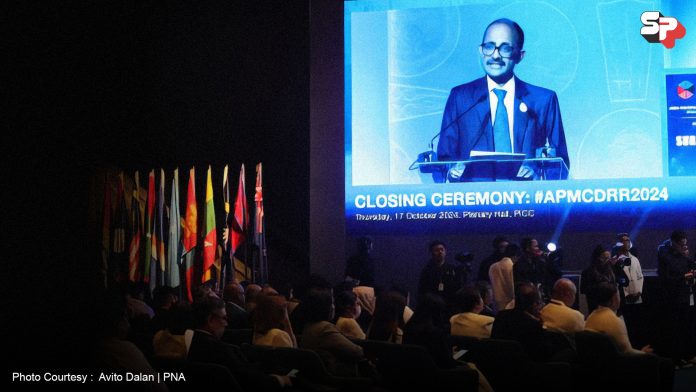MANILA – A week-long United Nations conference held in Manila has drawn attention to the need for countries in the Asia-Pacific region to whip up larger funding for disaster risk reduction.
At the closing ceremony of the Asia-Pacific Ministerial Conference on Disaster Risk Reduction (APMCDRR) in Pasay City on Thursday night, the United Nations Office for Disaster Risk Reduction (UNDRR) called on countries to shift priorities on “financing prevention and risk reduction before disasters occur.”
“This means instituting predictable and annual allocations from national budgets where possible,” UNDRR chief Kamal Kishore said.
“For donor countries, this means dedicating a larger percentage of your development assistance to disaster risk reduction and offering more accessible climate financing for adaptation.”
Citing the yet-to-be-released 2024 APMCDRR co-chairs’ statement with the Philippine government, Kishore said financing for DRR and prevention needs to considerably expand, while pooled funds and insurance products must increase.
The UNDRR estimates that the total insured losses from natural hazards and human-induced disasters in 2023 ran into USD291 billion, with the indirect socio-economic costs expected to be much larger.
It noted that despite this huge amount of losses, certain countries only earmark less than 1 percent of their national budgets for risk prevention.
The agency also found that from 2010 to 2018, for every USD100 spent on total development aid, as little as 47 cents were allocated for disaster risk reduction.
Countries in the Asia-Pacific, it added, are particularly prone to disasters and are disproportionately affected compared to other regions due to climate change, earthquakes, and coastal exposure, among others.
With this, both preventive investment costs and response costs increase, “raising the fiscal burden on budgets.”
“Understanding disaster risk in all its dynamic dimensions needs to be fast-tracked together with a stronger accounting of loss and damage,” Kishore said.
“This knowledge is foundational to designing risk reduction measures and to ensuring that the most at risk, people and assets, are protected.”
In the Philippines, the government is guided by the newly launched Philippine Public Financial Management (PFM) Reforms Roadmap 2024-2028, which identifies DRR and management as a key strategic focus area.
At a thematic APMCDRR session on Thursday, Budget Secretary Amenah Pangandaman said the PFM would introduce “classification of tagging systems” for disaster-related programs to easily track DRRM spending in agencies and local government units.
“We have already started on that roadmap, on that tool, and hopefully it will help us manage more our budget in a more measurable and sustainable way,” she said.
READ: UN hails ‘people-centered’ PH approach in disaster risk reduction
In addition to financing, Kishore suggested maximizing technology, especially in the management of data and integration of local knowledge.
“On the high-tech end, this means leveraging emerging technologies, such as artificial intelligence and machine learning to scale up analytics and forecasting models,” he added.
Another highlight of the outcome statement, he said, is a call for countries to develop and strengthen early warning systems for all kinds of hazards similar to the ones used for tsunamis.
“The success of the region in strengthening tsunami early warning systems since the 2004 Indian Ocean tsunami gives me confidence that we can replicate this for other hazards to and all communities,” Kishore said.
“This means our goal of protecting everyone on earth through early warning systems is entirely achievable in a short time.”
The UNDRR defines disaster risk as the likelihood of loss of life, injury, or damaged assets due to the combined effects of a hazard (calamity, pandemic, pollution, etc.) and conditions that make people vulnerable and exposed.
These conditions or “underlying disaster risk drivers” include poverty and inequality, climate change, rapid urbanization, and the lack of disaster risk considerations in land management, as well as other compounding factors, such as demographic change, non-disaster-risk-informed policies, and lack of incentives for private DRR investment. (PNA)

